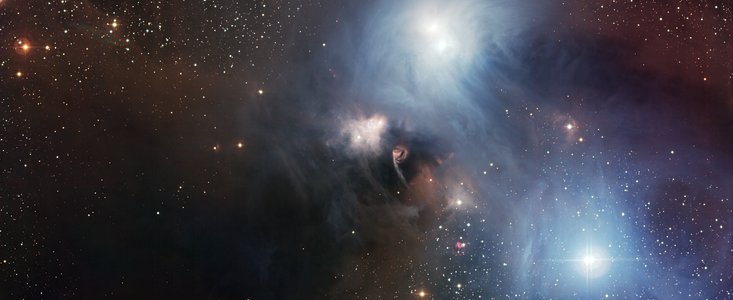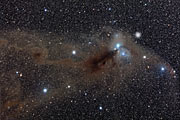Persbericht
R Coronae Australis: een kosmische aquarel
30 juni 2010
Dit schitterende overzicht van het gebied rond de ster R Coronae Australis bestaat uit opnamen die zijn gemaakt met de Wide Field Imager (WFI) van de ESO-sterrenwacht op La Silla (Chili). R Coronae Australis staat in het hart van een nabij stervormingsgebied en is omgeven door een subtiele blauwachtige reflectienevel die in een enorme stofwolk is ingebed. De afbeelding vertoont verrassende nieuwe details in dit indrukwekkende hemelgebied.
De ster R Coronae Australis maakt deel uit van een van de meest nabije en spectaculaire stervormingsgebieden. Dit portret is vastgelegd met de Wide Field Imager (WFI) van de 2,2-meter MPG/ESO-telescoop op de La Silla-sterrenwacht in Chili. De afbeelding is samengesteld uit twaalf afzonderlijke opnamen, genomen door rood-, groen- en blauwfilters.
De afbeelding toont een hemelgebied dat ongeveer zo breed is als de volle maan. In werkelijkheid is de nevel, die op een afstand van ongeveer 420 lichtjaar in het kleine sterrenbeeld Corona Australis (Zuiderkroon) staat, ongeveer vier lichtjaar groot. Het complex is genoemd naar de ster R Coronae Australis, die in het midden van de foto staat. Net als enkele andere sterren in dit gebied behoort deze tot de klasse van zeer jonge sterren die in helderheid variëren en nog altijd omgeven zijn door de wolken van gas en stof waaruit zij zijn ontstaan.
De intense straling die door deze hete, jonge sterren wordt afgegeven, reageert met het omringende gas. Ze wordt ofwel direct gereflecteerd ofwel geabsorbeerd en weer uitgezonden op een andere golflengte. Deze ingewikkelde processen, die worden bepaald door de fysische kenmerken van het interstellaire medium en de eigenschappen van de sterren, zijn verantwoordelijk voor de schitterende kleuren van de nevels. De lichtblauwe nevel op deze foto is grotendeels het gevolg van de weerkaatsing van sterlicht aan kleine stofdeeltjes. De jonge sterren in het R Coronae Australis-complex hebben ongeveer dezelfde massa als de zon en produceren niet genoeg ultraviolette straling om een aanzienlijk deel van het omringende waterstofgas te ioniseren. Daardoor heeft de wolk niet de karakteristieke rode kleur zoals veel stervormingsgebieden die vertonen.
De enorme stofwolk waarin de reflectienevel is ingebed, is hier tot in indrukwekkend kleine details te zien. Door de subtiele kleuren en uiteenlopende structuren in de stofwolken doet de foto denken aan een impressionistisch schilderij. Van het midden naar linksonder op de foto strekt zich een duidelijke stofband uit. Hier wordt het zichtbare licht van de sterren die in de gaswolk ontstaan volledig door het stof geabsorbeerd. Om deze objecten te kunnen zien, moet de wolk op langere golflengten worden waargenomen, met een camera die infraroodstraling kan detecteren.
R Coronae Australis zelf is niet zichtbaar met het blote oog, maar het kleine, kroonvormige sterrenbeeld waar hij deel van uitmaakt, is vanaf een donkere plek gemakkelijk herkenbaar in de buurt van het grotere sterrenbeeld Schutter en de rijke sterwolken van het centrum van de Melkweg.
Meer informatie
ESO, de Europese Zuidelijke Sterrenwacht, is de belangrijkste intergouvernementele sterrenkundeorganisatie in Europa, en het meest productieve astronomische observatorium ter wereld. ESO wordt ondersteund door 14 landen: België, Denemarken, Duitsland, Finland, Frankrijk, Italië, Nederland, Oostenrijk, Portugal, Spanje, Tsjechië, het Verenigd Koninkrijk, Zweden en Zwitserland. ESO voert een ambitieus programma uit, gericht op het ontwerp, de bouw en het beheer van krachtige grondobservatoria die astronomen in staat stellen om belangrijke wetenschappelijke ontdekkingen te doen. ESO speelt ook een leidende rol bij het bevorderen en organiseren van samenwerking op sterrenkundig gebied. ESO beheert drie waarnemingslocaties van wereldklasse in Chili: La Silla, Paranal en Chajnantor. Op Paranal staat ESO’s Very Large Telescope (VLT), de meest geavanceerde optische sterrenwacht ter wereld. Ook is ESO de Europese partner van de revolutionaire telescoop ALMA. Daarnaast is ESO momenteel bezig met ontwerpstudies voor de 42-meter Europese Extremely Large optische/nabij-infrarood Telescoop (E-ELT), die ‘het grootste oog op de hemel’ ter wereld zal worden.
Links
- Eerdere compositiefoto van R Coronae Australis: http://www.eso.org/public/news/eso0031/
Contact
Richard Hook
ESO, Survey Telescopes PIO
Garching, Germany
Tel: +49 89 3200 6655
E-mail: rhook@eso.org
Marieke Baan (press contact Nederland)
ESO Science Outreach Network
and NOVA Informatie Centrum
Tel: +31(0)20-5257480
Email: eson-netherlands@eso.org
Over dit bericht
| Persberichten nr.: | eso1027nl |
| Naam: | R Coronae Australis |
| Type: | Milky Way : Nebula : Appearance : Reflection |
| Facility: | MPG/ESO 2.2-metre telescope |
| Instruments: | WFI |




